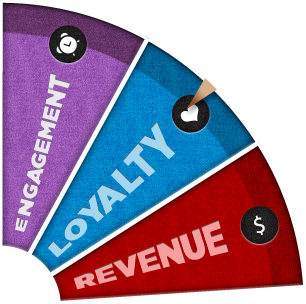 Gamification describes the use of game design techniques, game thinking, and game mechanics to enhance non-game contexts. Typically, gamification applies to non-game applications and processes to encourage people to adopt them or to influence how they are used.
Gamification describes the use of game design techniques, game thinking, and game mechanics to enhance non-game contexts. Typically, gamification applies to non-game applications and processes to encourage people to adopt them or to influence how they are used.
Gamification works by encouraging users to engage in desired behaviors, by showing a path to mastery and autonomy, by helping to solve problems and not being a distraction, and by taking advantage of humans' psychological predisposition to engage in gaming. The technique can encourage people to perform chores that they ordinarily consider boring, such as completing surveys, shopping, filling out tax forms, or reading web sites.
Available data from gamified websites, applications, and processes indicate potential improvements in areas like user engagement, ROI, data quality, timeliness, or learning.
Early examples of gamification are based on rewarding points to people who share experiences on location-based platforms such as Facebook's "Place" feature, Foursquare, and Gowalla. But as of September 2010, gamification started to be used by marketers and website product managers as a tool for customer engagement, and encouraging desirable website usage behavior. Gamification is readily applicable to increasing engagement on sites built on social network services. One site, DevHub, increased the number of users who completed their online tasks from 10% to 80% after adding gamification elements.
Gartner Group predicts gamification will be a key trend that every CIO, IT planner and enterprise architect must be aware of as it relates to business. Indeed, venture capitalists and experts consider gamification to be the most promising area in gaming, observing that half of all companies seeking funding for consumer software applications are mentioning game design in their presentations. Fact is that innovative companies such as SAP, IBM, EMC, CA, Deloitte, Microsoft, and many others have started using gamification for consumer and non-consumer facing applications and processes.
In November 2011 Australian broadcast and online media partnership Yahoo!7 launched, for instance, its Fango mobile app, which allows TV viewers to interact with shows via several gamification techniques like check-ins and badges. The app also offers integration with social networking sites and live viewer discussions, marking a significant strategic shift for parent company Seven West Media (known mainly for its traditional role as one of Australia's main free-to-air TV networks). As of February 2012, the app had been downloaded more than 200 000 times since its launch.
Or fitness site Fitocracy started to use gamification to encourage its users to exercise more effectively. Users are awarded varying numbers of points for activities they perform in their workouts and gain levels based on points collected. Users can also complete quests (sets of related activities) and gain achievement badges for fitness milestones.
Some other applications of gamification include: employee training programs, wellness and other personal activities, financial services websites, online and in-person shopping; primary education, extreme sports, project management, enhancing loyalty programmes, science, social networks, surveys, sustainability, call center, market research.
Experts anticipated that the technique would also be applied to health care, financial services, transportation, government, employee training, and other activities. (Source: Wikipedia)


